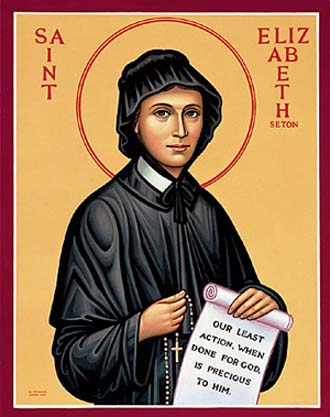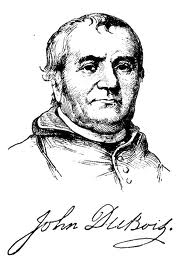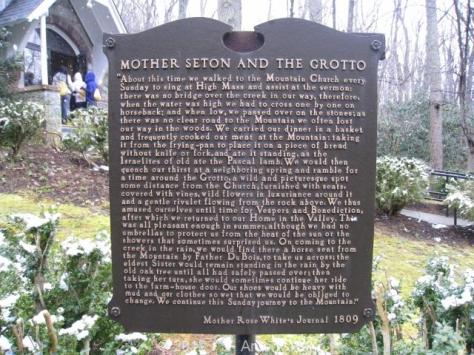Above the lovely valley of Emmitsburg, Frederick County, Maryland, just 12 miles south of Gettysburg, situated high on the mountainside, where nature displays itself in all its picturesque and wild glory, sits the wondrous National Shrine Grotto of Lourdes – a shrine that traces its lineage to the very beginnings of the spread of Catholicism in America.
.

.
Incredibly linked with Saint Elizabeth Ann Seton, the first native-born American to be canonized by the Catholic Church, the shrine is one of the oldest known American replicas of the revered French shrine, dating to about 1875, two decades after the apparitions at Lourdes (1858), although the site had already been in use since 1805, when Father John Dubois founded it as a place of prayer and devotion.
This holy mountain sanctuary of historic importance to the Catholics of America has been devoutly tended throughout the years and attracts thousands of pilgrims from all parts of the world for prayer and meditation..
My wife Assuntha and I, along with my son Subas, daughter-in-law Maria Ligia, and grandson Rohan, visited this holy shrine on February 11, 2012, the feast day of Our Lady of Lourdes. It was snowing that day; nevertheless, we thank the Almighty for leading us to Emmitsburg, where Saint Elizabeth Ann Seton, the first American saint, trod a long time ago..
The Story of Our Lady’s Grotto
In the year 1728, a group of Catholics left St. Mary’s City on the St. Mary’s River in Maryland and traveled westward seeking peace and religious freedom. These Catholics were children and grandchildren of the early colonists of Maryland.
.
Among the refugees of 1728 were the members of the William Elder family, forebears of Archbishop Elder of Cincinnati. They traveled to the west almost one hundred miles to the Blue Ridge Mountains, located in the eastern United States, starting at its southern-most portion in Georgia, then ending northward in Pennsylvania. They stopped at the first range of the Blue Ridge Mountains, giving the beloved name “St. Mary’s Mount” to its eastern prominence.
.
.
Finding rest in a peaceful valley of “surpassing beauty,” which they called “St. Joseph’s Valley,” they took the land and built their homes. Over the years, missionary priests who were compelled to travel in disguise due to the anti-Catholic laws in effect at the time provided them with spiritual care.
.
The Elder farmhouse became known as “Elder’s Station.” Here, Mass was celebrated, and the dead were buried in the adjoining cemetery.
.
Father John Dubois and the Grotto

In 1805, after the Revolution and the constitutional grant of religious freedom, Father John Dubois, a refugee priest from France, came to this area and settled. This priest, who later became Bishop of New York, was, in the year 1794, appointed pastor of Frederick by Bishop Carroll. His pastorate included all of western Maryland and western Virginia. Of all the lovely places he visited in this wild and mountainous country, he came to love most the Mountain of Mary and the Valley of St. Joseph.
.
In 1805, Father John Dubois built St. Mary’s Church on St. Mary’s Mount, at the site of the present Grotto parking lot.
For over a century, this church was a beacon calling the faithful to Mass from the Valley and a reminder to them to keep the Faith. Numerous paths, traceable up to this day and all converging on the church, show with what fidelity the Catholics practised their faith.
To this very day, the people of the valley, now members of St. Anthony’s parish, exhibit a strong, living, and very simple faith. Families have lived here for many generations. Very few move away. They are happy people with a proud awareness of their ancient Catholic heritage. After all, very few parishes in the United States can claim that they have had uninterrupted priestly service for 235 years. Only a few Americans can honestly say that holy persons taught their ancestors. They are the spiritual children of Saint Mother Seton
On the lower terraces, Father Dubois began the first building of Mount Saint Mary’s College and Seminary in 1808..
Father Simon Gabriel Bruté
One of the holy founders of the Grotto, Father Simon Gabriel Bruté came to the mountain in 1812. This remarkable priest, later the first Bishop of Vincennes, Indiana, combined in his person the talents and attainments of a scholar, theologian, master of the spiritual life, teacher, and pastor of souls.
.

.
This spiritual enthusiast reveled in the beauty of the Mountain of Mary and the Valley of St. Joseph. Father Bruté brought to the mountain and the Valley a program of holy activity.
.
.
Remembering the orderly, cultivated hills of his native France, Father Bruté strove to “smooth the frown from nature’s erring face.” Springs were cleaned out, covered and named for saints; terraces and paths found their way up the rugged Mountainside to the. church and Grotto. They were constructed so well that we walk along them today and the stone walls remain. He attached crosses to the trees on the path between the church and the Grotto so that one might make the Stations of the Cross along this beautiful woodland avenue..
.On the left side of the Grotto parking lot. several hundred yards back in the mountains, behind the site of Father John Dubois’ church, is the famous Grotto, the most ancient shrine consecrated to Mary, the mother of God, in continuous existence in the original thirteen colonies, on which was begun in 1875 the first Lourdes Grotto in America..
Aisle of the Corpus Christi Procession
A memorable devotion centered about the old Grotto was the annual Corpus Christi procession.
It was during Father John Baptist Purcell’s (later Archbishop of Cincinnati, Ohio) term as president of the college (1829-1833) that these annual processions at the Grotto over Father Bruté’s paths began, or at least began to be chronicled, and another charm was added to the Mountain.
.
The lovely road lying between the site of the old church and the Grotto is still called the “Aisle of the Corpus Christi Procession.“
.
Corpus Christi Chapel
This stone chapel was built in 1906 on the site of the original Grotto discovered by Father John DuBois in 1805.
There is a legend that Father John Dubois, on one of his pastoral journeys, was attracted by a light on the mountain and found this spot, one of the loveliest in the world..
Those of a more practical mind may surmise that Father John Dubois was seeking the source of the stream which flowed out of the ravine into the valley below. Just what did the priest find on his day of discovery?
He climbed a steep ascent through a rocky ravine along a tumbling torrent, which was much broader and more unruly than at present, for its volume has lessened since the trees were cut down on the mountain. He came upon a lovely clearing, a masterpiece of natural beauty. Sharply sloping hills from almost every side formed a natural amphitheater where nature “displayed itself in all its wild and picturesque beauty.” In the center of this clearing, where now the stone chapel stands, he saw a mound, shaded by the branches of an ancient oak. Such huge oak trees are seen even to this day on the mountain, survivors of the woodsmen’s devastation.
In any event, Father John Dubois found the Grotto-site, a dell of breath-taking beauty, and there erected a rude cross..
Saint Elizabeth Ann Seton and the Grotto
.
 .
.
Saint Elizabeth Ann Seton, the first Superior of the Sisters of Charity, dedicated to serving the poor, was the next holy person to love the Grotto. She came in the year 1809 to the Mountain where, before moving to the Valley, she and her little band of pioneer sisters lived for six weeks near the Church and the Grotto. Here her sister-in-law Harriet received the gift of Faith. And, after Mother Seton moved to the Valley, the Grotto was to her the most loved spot on the mountain. It is possible that Mother Seton first called it the Grotto, for we find this reference in one of her letters, dated May 27, 1810:
“If you could breathe our mountain air and taste the repose of the deep woods and streams. Yesterday we all, about twenty children and sisters, dined in our grotto on the mountain, where we go Sundays for the divine office.“
.
Rosetta Landry White, called Mother Rose, who succeeded Mother Seton gives further details of this holy association with the Grotto:
“About this time we walked to the Mountain Church every Sunday to sing at High Mass and assist at the sermon; there was no bridge over the creek in our way, therefore, when the water was high, we had to cross one by one on horseback; and when low, we passed over on the stones; as there was no clear road to the Mountain we often lost our way in the woods. We carried our dinner in a basket and frequently cooked our meat at the mountain; taking it from the frying-pan to place it on a piece of bread without a knife or fork, and ate it standing, as the Israelites of old ate the Pascal Lamb. We would then quench our thirst at a neighboring spring and ramble for a time around the Grotto, a wild and picturesque spot some distance from the Church, furnished with seats, covered with vines, wild flowers in luxuriance around it and a gentle rivulet flowing from the rock above. We thus amused ourselves until time for Vespers and Benediction after which we returned to our Home in the Valley. This was all pleasant enough in summer, although we had no umbrellas to protect us from the heat of the sun or the showers that sometimes surprised us. On coming to the creek in the rain, we would find there a horse sent from the Mountain by Father Du Bois, to take us across; the eldest Sister would remain standing in the rain by the old oak tree until we all has safely passed over; then taking her turn, she would sometimes continue her ride to the farm-house door. Our shoes would be heavy with mud and our clothes so wet that we would be obliged to change. We continue this Sunday journey to the Mountain.” – Mother Rose White’s Journal 1809.
The eldest Sister, mentioned by Mother Rose must definitely be Mother Seton.
.
.
The first statue of Our Lady was placed in the Grotto in Mother Seton’s time. Truly Mother Seton loved this Grotto. It entered into her daily thoughts, conversations, and writings. In a letter to Father Brute, she prayed for “one only heart, clear for my thoughts as the stream of your Grotto.“
.
RELATED ARTICLES
- Bishop John Dubois: Pioneer (emmitsburg.net)
- John Dubois (en.wikipedia.org)
- Saint Elizabeth Ann Seton Foundress of the Sisters of Charity of Saint Joseph’s (1774-1821) (dailygospel.org)
- Pilgrimage to the Grotto Shrine of Our Lady of Lourdes – Emmitsburg, Maryland (tvaraj.com)
- St. Elizabeth Ann Seton, “a woman of faith, for a time of doubt and uncertainty…” (insightscoop.typepad.com)













